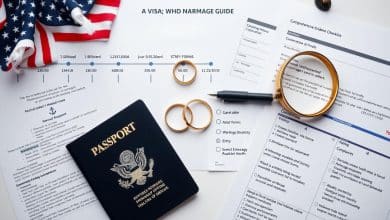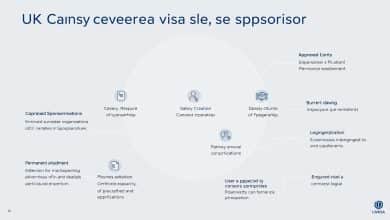Canada Visa Sponsorship vs Spousal Sponsorship: Key Differences, Eligibility & Which Path Fits Your Case
Families dreaming of a life together in Canada face an important choice.
They must select the right sponsorship pathway. This decision shapes their entire immigration journey.
Understanding the difference between these two primary options is critical. The choice impacts processing times, work permit eligibility, and travel flexibility. It also affects appeal rights if an application faces challenges.
Canadian law offers distinct streams for couples. The Inland option is for partners already living together in the country. The Outland pathway suits those where the spouse or partner resides abroad.
This guide provides a clear comparison. It details eligibility rules, financial obligations, and required documentation. The goal is to empower couples with the knowledge for a successful reunification.
Whether someone is a Canadian citizen living overseas or a permanent resident at home, this information is vital. It is the first step toward building a future together under Canadian law.
Introduction and Overview
Couples seeking to build their lives together in the northern nation must evaluate their sponsorship options thoroughly. The government’s commitment to family reunification shapes these important decisions.
Context of Canadian Spousal and Visa Sponsorship
Canada’s immigration system welcomes approximately 80,000 spouses, partners, and children annually. This represents a significant portion of the country’s broader goal to admit over 400,000 newcomers each year.
The process allows citizens and permanent residents to sponsor their foreign spouse or partner. Most applications receive decisions within 12 months, making timely reunification possible.
Purpose of Comparing Sponsorship Paths
Understanding the differences between application types helps couples make informed choices. Each pathway has distinct requirements affecting work eligibility and travel flexibility.
Strategic selection minimizes separation time and maximizes legal protections. This comparison empowers couples to navigate the immigration process successfully.
Family class immigration strengthens communities and contributes to the nation’s social fabric.
The initial choice between application streams determines eligibility for open work permits and appeal rights. Careful consideration ensures the smoothest pathway to permanent residence.
Understanding the Basics of “visa sponsorship vs spousal sponsorship Canada”
Before submitting any sponsorship paperwork, couples must comprehend the two primary application categories. These pathways operate under distinct legal frameworks with different implications for work permits and appeal rights.
Defining Sponsorship and Partner Categories
Spousal sponsorship refers to the process where a Canadian citizen or permanent resident brings their foreign partner to Canada. The system recognizes various relationship types including married spouses and common-law partners.
A common-law partner is someone who has lived with the sponsor continuously for at least twelve months. Conjugal partners face significant barriers preventing cohabitation but maintain committed relationships.
Legal Framework and Key Eligibility Requirements
The Canadian Immigration and Refugee Protection Act governs all sponsorship applications. This legislation establishes the Spouse or Common-Law Partner Class and Family Class pathways.
Sponsors must be at least 18 years old and typically reside in Canada. Citizens living abroad need concrete plans to return when their partner gains permanent residence status.
Both sponsors and applicants must meet specific eligibility criteria. These include financial stability, clean criminal records, and passing medical examinations.
Eligibility Criteria and the Application Process
A successful sponsorship hinges on meeting specific criteria and meticulously following the application process. Both the sponsor and the applicant must satisfy distinct requirements set by immigration authorities.
This stage determines if a couple can proceed with their reunification plans. It involves financial commitments, background checks, and gathering substantial evidence.
Requirements for the Sponsor and the Applicant
The person acting as the sponsor must be a Canadian citizen or a permanent resident. They need to be at least 18 years old and live in Canada.
Citizens living abroad must prove concrete plans to return. Sponsors cannot be receiving most forms of social assistance.
A key requirement is signing a three-year undertaking of financial support. This legally binding promise covers basic needs like food, clothing, and housing.
The sponsored person, or applicant, must also be 18 years or older. They must prove the relationship is genuine and pass medical and security checks.
Differences in Application Packages and Documentation
The application process involves submitting two connected forms simultaneously. One is for the sponsor’s eligibility, and the other is for the applicant’s permanent residence.
While the forms are similar, a critical checkbox distinguishes between Inland and Outland applications. The required documentation is extensive for both paths.
Couples must provide proof of status, relationship evidence, and police certificates. The total government fees for the application are approximately $1,290.
Exploring Benefits and Drawbacks of Each Path
The path a couple selects for their application directly shapes their daily life and legal standing during the processing period. Each option offers a distinct set of advantages and limitations.
Careful consideration of these factors is essential for making an informed decision that aligns with a couple’s specific circumstances.
Pros and Cons of Inland Sponsorship
This category is designed for partners already living together in the country. The primary benefit is the ability to remain together throughout the entire process.
A significant advantage is eligibility for an Open Work Permit. This allows the foreign spouse to work while their application is being reviewed.
The main drawback involves travel restrictions. Leaving the country is risky, as re-entry is not guaranteed. If denied entry, the application may be considered abandoned.
Processing times can be lengthy, currently listed at many months. Another limitation is the lack of formal appeal rights if the application faces a refusal.
Advantages and Limitations of Outland Sponsorship
This pathway is ideal when the applicant resides outside the country or requires travel flexibility. The sponsored person can stay in their home country during processing.
A key benefit is generally faster processing times, which can vary from several months to over a year depending on the location.
Applicants enjoy greater freedom to travel. They also have the right to a formal appeal if the application is refused, providing an important safety net.
The potential disadvantage is separation if the partner cannot obtain a visitor visa to make trips during the waiting time.
Residency Requirements and Work Permit Considerations
Understanding where sponsors must reside and how partners can work legally during processing is essential. These practical factors significantly influence daily life while applications are reviewed.
Residency and Living Arrangements for Sponsors
The sponsor must be living in Canada when submitting the application. Canadian citizens abroad can sponsor under the Family Class pathway.
They need to show concrete plans to return when their partner gains permanent resident status. Evidence includes job offers, property agreements, or educational enrollment.
Open Work Permit Eligibility for Spouses and Partners
An open work permit allows employment with any Canadian employer during processing. This benefit is available to Inland applicants who meet specific criteria.
Applicants must have valid temporary resident status and live with their sponsor. Recent changes extend this option to some Outland applicants present in the country.
Processing typically takes about four months. The permit provides financial independence while waiting for permanent residence decisions.
Travel Flexibility and Its Impact on Applications
Travel rules differ significantly between application types. Inland applicants face restrictions on leaving the country.
Border officers may deny re-entry, risking application abandonment. Outland applicants maintain travel freedom but may encounter visa challenges due to dual intent concerns.
Documenting Your Case: Process and Practical Checklist
Proper documentation separates successful applications from those facing delays or refusal. This phase requires careful attention to every detail in the application package.
Preparing Your Application Package
The process begins with downloading the correct forms from the IRCC website. Applicants must select the appropriate category and document checklist IMM 5533.
Payment of $1,290 in government fees precedes submission. Both the sponsor’s eligibility application and the partner’s permanent residence application submit together.
Choosing between Inland and Outland categories requires careful consideration. This selection cannot change after submission without starting over completely.
Gathering Evidence for an Authentic Relationship
Proving relationship genuineness is the most critical aspect. Immigration officials look for comprehensive evidence of a real partnership.
Married couples should provide wedding certificates and celebration photos. Common-law partners need proof of twelve months continuous cohabitation.
Strong evidence includes joint financial accounts, shared bills, and insurance policies. Photos spanning the relationship timeline and affidavits from friends add credibility.
Processing times range from 8 to 28 months depending on the category. Complete, accurate documentation helps avoid common refusal reasons like insufficient evidence.
Conclusion
The journey concludes with understanding how initial choices impact long-term outcomes. Selecting between application pathways depends entirely on a couple’s living situation and needs. This decision affects work eligibility, travel freedom, and processing timelines.
Thorough preparation remains the cornerstone of success. Complete documentation proving a genuine relationship is essential. Applicants should verify current processing times directly from official sources.
Sponsors must recognize their three-year financial undertaking is binding. This commitment continues even if the relationship changes status. Understanding these obligations beforehand prevents future complications.
For families seeking reunification, careful planning and honest disclosure pave the way. Staying informed about policy updates ensures a smoother path toward becoming a permanent resident. The right preparation turns immigration goals into achievable realities.
For more information, explore the official visa website mentioned in this article:
You will be redirected to another website
FAQ
What is the main difference between family class sponsorship and economic immigration programs?
Family class sponsorship, like sponsoring a spouse or common-law partner, is based on family reunification. It allows a Canadian citizen or permanent resident to bring a family member to Canada. Economic programs are based on skills, work experience, and the ability to contribute to the Canadian economy.
Can a permanent resident in Canada sponsor their partner to become a permanent resident?
Yes, a person with permanent resident status can sponsor their spouse or common-law partner. The sponsor must meet specific requirements, such as not receiving social assistance for reasons other than a disability and being able to financially support the applicant.
What is an open work permit, and who is eligible for one during the sponsorship process?
An open work permit allows a person to work for almost any employer in Canada. Spouses and common-law partners being sponsored from inside Canada under the inland sponsorship program are typically eligible to apply for this permit while their application is being processed.
How long does the spousal sponsorship application process usually take?
Processing times vary based on the application category and the applicant’s country of residence. Inland applications often take around 12 months, while outland applications can have different processing times depending on the visa office handling the case.
What evidence is needed to prove a common-law relationship for sponsorship?
Applicants must provide documents showing they have lived together continuously for at least one year. This can include joint bank accounts, shared leases or mortgages, and other proof of a committed, marriage-like relationship to satisfy Immigration, Refugees and Citizenship Canada (IRCC).
If a sponsorship application is refused, can the couple appeal the decision?
Yes, if an application under the Family Class is refused, the sponsor generally has the right to appeal the decision to the Immigration Appeal Division (IAD) of the Immigration and Refugee Board. There are strict deadlines for filing an appeal.
Published on: 17 de October de 2025

Abiade Martin
Abiade Martin, author of WallStreetBusiness.blog, is a mathematics graduate with a specialization in financial markets. Known for his love of pets and his passion for sharing knowledge, Abiade created the site to provide valuable insights into the complexities of the financial world. His approachable style and dedication to helping others make informed financial decisions make his work accessible to all, whether they're new to finance or seasoned investors.






